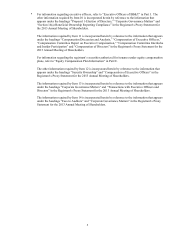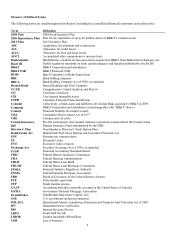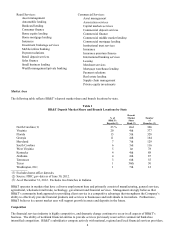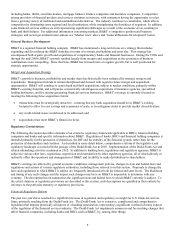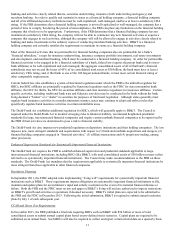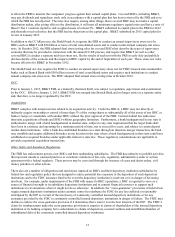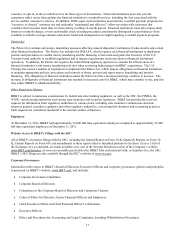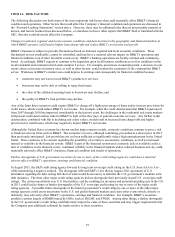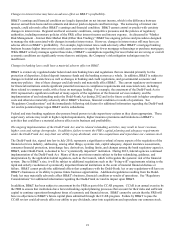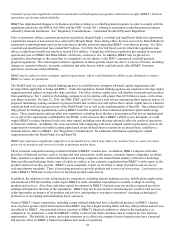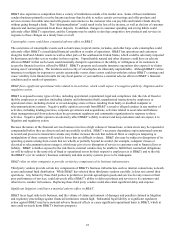BB&T 2012 Annual Report Download - page 35
Download and view the complete annual report
Please find page 35 of the 2012 BB&T annual report below. You can navigate through the pages in the report by either clicking on the pages listed below, or by using the keyword search tool below to find specific information within the annual report.
13
Federal and state banking regulators also have broad enforcement powers over Branch Bank, including the power to impose
fines and other civil and criminal penalties, and to appoint a conservator (with the approval of the Governor in the case of a
North Carolina state bank) in order to conserve the assets of any such institution for the benefit of depositors and other
creditors. The North Carolina Commissioner of Banks also has the authority to take possession of a North Carolina state
bank in certain circumstances, including, among other things, when it appears that such bank has violated its charter or any
applicable laws, is conducting its business in an unauthorized or unsafe manner, is in an unsafe or unsound condition to
transact its business or has an impairment of its capital stock.
Payment of Dividends; Capital Requirements
The Parent Company is a legal entity separate and distinct from Branch Bank and its subsidiaries. The majority of the Parent
Company’ s revenue is from dividends paid by Branch Bank. Branch Bank is subject to laws and regulations that limit the
amount of dividends it can pay. In addition, BB&T and Branch Bank are subject to various regulatory restrictions relating to
the payment of dividends, including requirements to maintain capital at or above regulatory minimums, and to remain “well-
capitalized” under the prompt corrective action regulations summarized elsewhere in this section. Federal banking regulators
have indicated that banking organizations should generally pay dividends only if (1) the organization’ s net income available
to common shareholders over the past year has been sufficient to fully fund the dividends and (2) the prospective rate of
earnings retention appears consistent with the organization’ s capital needs, asset quality and overall financial condition.
BB&T’ s 2013 capital actions will depend on the FRB’ s review of BB&T’ s 2013 capital plan.
North Carolina law states that, provided a bank does not make distributions that reduce its capital below its applicable
required capital, the board of directors of a bank chartered under the laws of North Carolina may declare such distributions as
the directors deem proper.
The FRB and the FDIC have issued substantially similar risk-based and leverage capital guidelines applicable to banking
organizations they supervise, including BHCs and banks. Under the current risk-based capital requirements, BB&T and
Branch Bank are each generally required to maintain a minimum ratio of total capital to risk-weighted assets (including
certain off-balance sheet activities, such as standby letters of credit) of 8%. At least half of the total capital must be
composed of common shareholders’ equity excluding the over or underfunded status of postretirement benefit obligations,
unrealized gains or losses on debt securities available for sale, unrealized gains on equity securities available for sale and
unrealized gains or losses on cash flow hedges, net of deferred income taxes; plus certain mandatorily redeemable capital
securities; less nonqualifying intangible assets net of applicable deferred income taxes and certain nonfinancial equity
investments. This is called “Tier 1 capital.” The remainder may consist of qualifying subordinated debt, qualifying preferred
stock and a limited amount of the ACL. This is called “Tier 2 capital.” Tier 1 capital and Tier 2 capital combined are referred
to as total regulatory capital.
The FRB requires BHCs that engage in trading activities to adjust their risk-based capital ratios to take into consideration
market risks that may result from movements in market prices of covered trading positions in trading accounts, or from
foreign exchange or commodity positions, whether or not in trading accounts, including changes in interest rates, equity
prices, foreign exchange rates or commodity prices. Any capital required to be maintained under these provisions may
consist of “Tier 3 capital” consisting of forms of short-term subordinated debt.
The FRB and the FDIC also have established minimum leverage capital requirements for banking organizations. These
requirements provide that banking organizations that meet certain criteria, including excellent asset quality, high liquidity,
low interest rate exposure and good earnings, and that have received the highest regulatory rating must maintain a ratio of
Tier 1 capital to total adjusted average assets of at least 3%. Institutions not meeting these criteria, as well as institutions with
supervisory, financial or operational weaknesses, are expected to maintain a minimum Tier 1 capital to total adjusted average
assets ratio at least 100 basis points above that stated minimum. BHCs experiencing internal growth or making acquisitions
are expected to maintain strong capital positions substantially above the minimum supervisory levels without significant
reliance on intangible assets. The FRB also continues to consider a “tangible Tier 1 capital leverage ratio” (deducting all
intangibles) and other indicators of capital strength in evaluating proposals for expansion or new activity.
In addition, the FRB and the FDIC have adopted risk-based capital standards that explicitly identify concentrations of credit
risk and the risk arising from non-traditional activities, as well as an institution’ s ability to manage these risks, as important
factors to be taken into account by each agency in assessing an institution’ s overall capital adequacy. The capital guidelines
also provide that an institution’ s exposure to a decline in the economic value of its capital due to changes in interest rates be
considered by the agency as a factor in evaluating a banking organization’ s capital adequacy. The agencies also require
banks and BHCs to adjust their regulatory capital to take into consideration the risk associated with certain recourse
obligations, direct credit subsidies, residual interest and other positions in securitized transactions that expose banking
organizations to credit risk.


